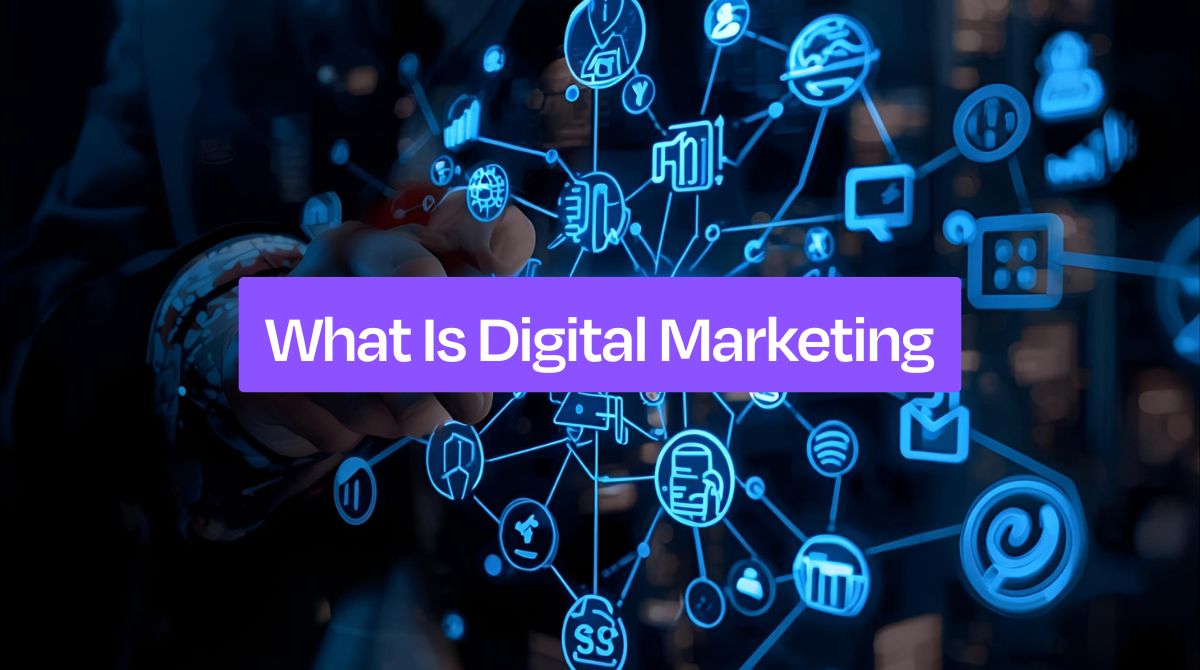Digital marketing promotes brands through online channels like search engines, social media, and mobile ads. Unlike traditional media, it connects with people on devices they use daily. With 90% of U.S. adults going online each day and 41% almost constantly, businesses gain powerful opportunities to reach and engage customers where they already spend time.
According to a Forrester Consulting study for Mailchimp, 88% of marketers believe they must increase automation and AI use to stay competitive.
In this blog, I'll share digital marketing types, key performance indicators, and much more.
TL;DR:
-
Digital marketing connects businesses with 90% of U.S. adults who go online daily through channels like SEO, email, content, PPC, and social media
-
Email marketing delivers highest ROI at $36-40 return per $1 spent, while 88% of marketers believe AI automation is critical for staying competitive
-
SEO costs $1,500-$5,000 monthly and takes 6-12 months for results, while PPC delivers immediate visibility but requires ongoing ad spend
-
Track success with key metrics: click-through rates (6.6% average for search ads), impressions for brand awareness, and cost-per-click for budget efficiency
How Digital Marketing Really Works
Digital marketing works by reaching customers online where they already spend time. Unlike traditional print, TV, and radio ads, the internet created new ways to connect with consumers, pushing businesses to adjust strategies and budgets to stay relevant.
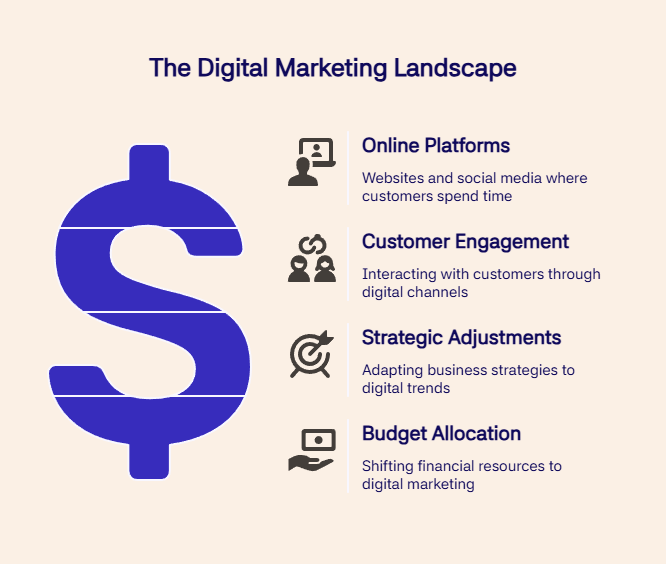
Today's digital marketing is powered by smartphones and portable devices that keep people connected everywhere they go. A 2022 Pew Research Center study found that 76% of American adults had made online purchases using their phones. This shows how digital marketing trends continue to follow consumers' mobile-first behaviors.
Types of Digital Marketing
Digital marketing has evolved since the 1990s and continues to adapt to new technology and consumer behavior. The five most effective types today are content marketing, email marketing, search engine optimization (SEO), affiliate marketing, and pay-per-click (PPC) advertising.
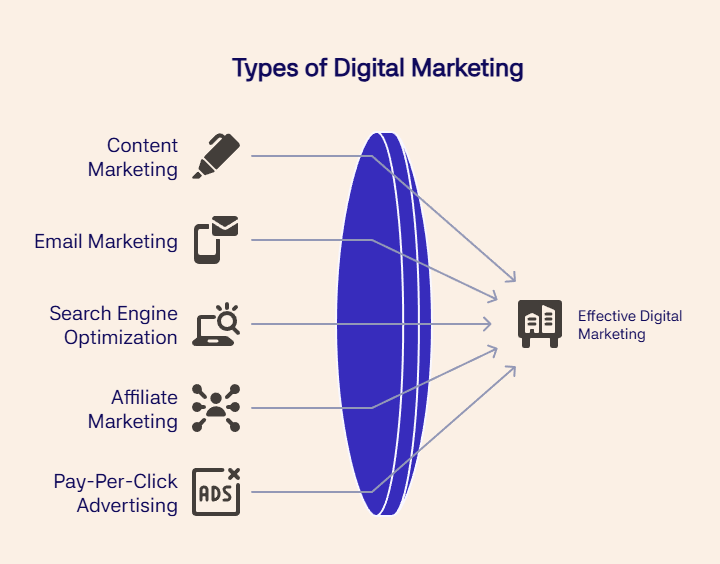
Content Marketing
Content marketing is a strategy that attracts and educates customers by sharing valuable information instead of direct promotions. Businesses use blog posts, videos, guides, infographics, and podcasts to build trust and authority. Its goal is to engage audiences, nurture relationships, and drive long-term growth by being genuinely helpful.
This strategy works through various formats that businesses can use to share valuable information:
-
Blog posts and articles
-
eBooks and downloadable guides
-
Email newsletters
-
How-to guides and tutorials
-
Infographics and visual content
-
Audio content like podcasts
-
Video content including YouTube Shorts
Content marketing delivers impressive results without breaking the bank. In 2022, 80% of marketers reported their content marketing strategy was very successful. The effectiveness of this approach is driving massive industry growth – the content marketing industry is projected to be worth $107 billion by 2026.
Email Marketing
Email marketing is a digital strategy that sends personalized messages directly to customers' inboxes to build relationships and increase sales. You can use it for newsletters, promotions, updates, and follow-ups.
Its strength lies in affordability, personalization, and consistent engagement, making it one of the highest ROI channels in digital marketing.
Email marketing lets you send personalized messages straight to your customers' inboxes to build stronger relationships and boost sales. This approach works because it's personal, affordable, and reaches people in a space they check regularly.
To get the best results from your email campaigns, focus on these proven strategies that increase engagement:
-
Include the recipient's name in both the email body and subject line for personalization
-
Keep your message focused with one clear call to action per email
-
Add an unsubscribe option to every email for legal compliance
-
Combine transactional emails (like order confirmations) with promotional content when appropriate
Email marketing continues to deliver strong returns because it reaches people in a space they check regularly – their inbox. When done right, it builds lasting relationships with customers and drives consistent business results.
Related Read: What is Internet Marketing
Search Engine Optimization (SEO)
Search Engine Optimization (SEO) is the process of improving a website’s visibility on search engines like Google. It works through on-page optimization, off-page link building, and technical improvements.
The goal is to rank higher in search results, drive organic traffic, and attract customers without paying for ads.
SEO works through three main areas:
-
On-page SEO - Optimizing your website content with target keywords to answer your audience's most important questions
-
Off-page SEO - Building external attention to your website, mainly through gathering quality backlinks from other sites
-
Technical SEO - Ensuring your website's backend runs smoothly, including page speed, image compression, and proper metadata
Unlike paid ads, SEO continues driving traffic to your business without ongoing costs once your rankings improve.
Affiliate Marketing
Affiliate marketing is a performance-based strategy where businesses reward affiliates for promoting their products or services. Affiliates earn a commission or fee when sales occur through their links. This approach leverages influencers, bloggers, and content creators to expand reach, build trust, and drive new customers cost-effectively.
This strategy works because you're tapping into someone else's established platform and audience trust. When trusted influencers vouch for your brand, their audience's existing trust naturally extends to your business as well. You get access to new customers without building those relationships from scratch.
Affiliate marketing takes different forms depending on the affiliate and your product. Some affiliates create detailed product reviews or unboxing videos, while others naturally incorporate your products into their content and link back to your company. The key is finding affiliates whose audience matches your target customers.
Pay-Per-Click (PPC)
Pay-Per-Click (PPC) is an online advertising model where businesses pay each time a user clicks on their ad. Platforms like Google Ads, Meta Ads, and Amazon Ads display these ads to targeted audiences. PPC delivers instant visibility, drives traffic quickly, and works best with optimized landing pages.
To get the most from your paid ads:
-
Improve your Quality Score in Google Ads to lower costs and improve ad placement
-
Create ads that directly address your target audience's pain points and needs
-
Optimize your landing pages so visitors take action after clicking your ad
PPC can become expensive quickly without proper planning and experience. Ad prices vary significantly across industries and keywords, so make sure you understand the bidding strategies on your chosen platform before diving in.
Key Performance Indicators (KPIs) in Digital Marketing
Measure digital marketing success by tracking key performance indicators (KPIs). The four most important are impressions, search engine rankings, click-through rate (CTR), and cost per click (CPC).
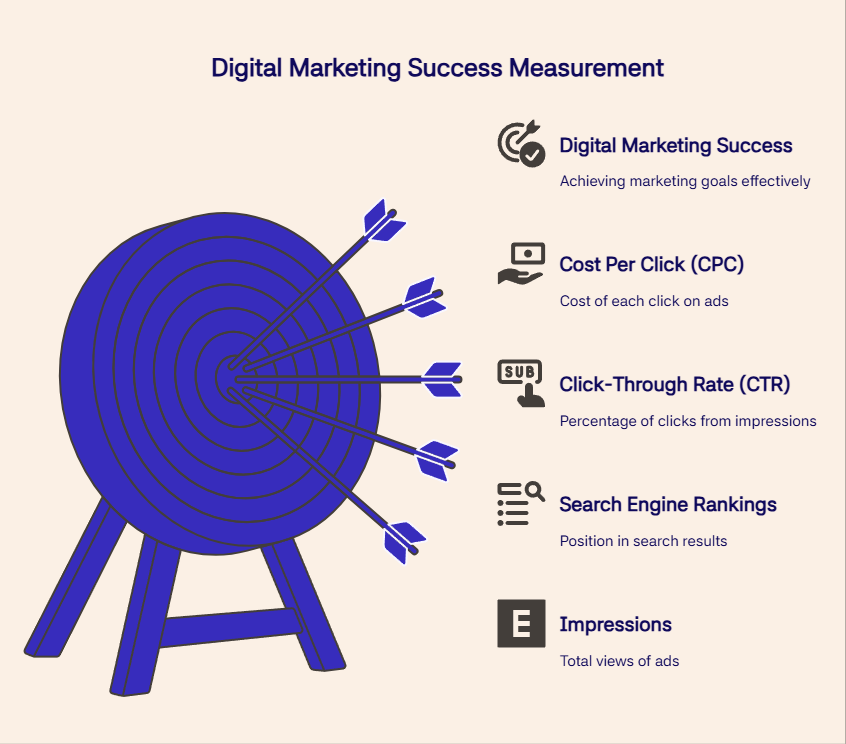
These metrics reveal brand visibility, search performance, engagement, and advertising efficiency, helping businesses optimize campaigns and achieve measurable growth.
Impressions
Impressions count how many times your ad or content appears to users, even without clicks. They track brand awareness and show message visibility. More impressions mean greater exposure, making this metric essential for strengthening brand presence and evaluating marketing reach.
Impressions differ from "reach" in an important way – impressions count every time your content appears, including multiple views by the same person, while reach only counts unique viewers.
You can track impressions using Google Ads or social media analytics tools to see how effectively your targeting strategy is working and adjust it to maximize your brand's exposure.
Search Engine Rankings
Search engine rankings show how easily customers find your website in search results. With over 2.6 billion online buyers worldwide, ranking high captures customers already searching for your products or services. Strong rankings increase visibility, attract qualified traffic, and directly boost business growth.
You can track your search engine performance using Google Analytics and SEO tools that measure key metrics like:
-
Number of targeted keywords you're ranking for
-
Amount of organic traffic your website receives
-
Amount of high-quality external links to your site
-
Monitoring these helps you understand if your SEO strategy is working and what adjustments you might need to make.
Click Through Rate
Click-through rate (CTR) measures the percentage of users who click your ad or content after seeing it. Calculate CTR by dividing clicks by impressions and multiplying by 100. A higher CTR proves your content is relevant and engaging, making it a key metric for audience resonance and campaign success.
Average CTR benchmarks vary by platform – search ads typically see around 6.6% while display ads average 0.6%. However, every business has its own baseline depending on industry and audience. A high CTR usually means your content is relevant and appealing to your target market.
You can track CTR using tools like Google Analytics to analyze performance across ads, keywords, and content. To set realistic CTR goals, look at industry benchmarks, your historical data, and your specific audience's behavior patterns on different platforms.
Cost Per Click
Cost per click (CPC) shows the amount a business pays for each ad click. Calculate CPC by dividing total ad spend by total clicks. For instance, spending $100 for 50 clicks equals a $2 CPC. This metric reveals ad cost efficiency and helps optimize campaign budgets for better returns.
This KPI helps you assess the financial efficiency of your advertising campaigns. A lower CPC means you're getting more clicks for your budget, which typically indicates a more cost-effective campaign. It's especially useful for understanding if your ads are reaching the right audience at the right price.
You can track CPC in real-time using platforms like Google Ads, which provide detailed performance data. Monitoring CPC helps you make smarter budget decisions and optimize your campaigns for better cost efficiency.
How Much Will Digital Marketing Cost My Business?
Digital marketing costs vary by service and business size.
In 2025, SEO services average $1,500–$5,000 per month, PPC management typically ranges $2,000–$10,000+ per month (excluding ad spend), social media marketing costs $1,000–$7,500 monthly, and content marketing ranges $2,000–$10,000 per month.
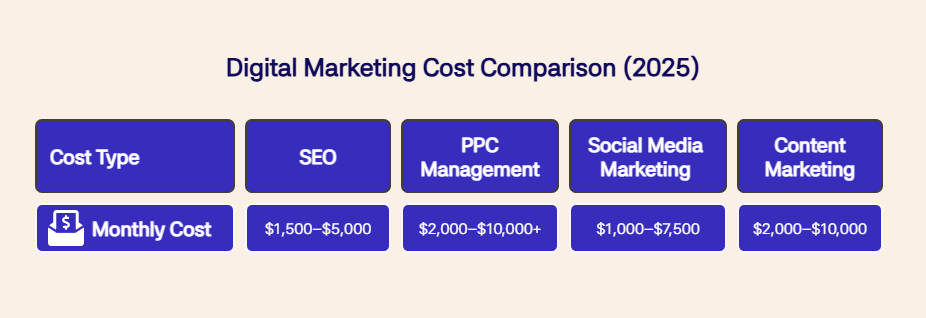
Small businesses spend less, while large firms invest tens of thousands in full-service campaigns.
You can choose from several pricing models depending on your needs.
Hourly rates work well for specific projects, while retainer-based pricing offers ongoing support for long-term strategies.
Performance-based pricing ties costs directly to results like leads or sales, which can be ideal if you're focused on measurable ROI.
The smartest approach is starting with clear goals and realistic expectations. Whether you work with an agency or handle marketing in-house, focus on channels that align with your audience and business objectives rather than trying to do everything at once.
How Do I Create and Implement a Digital Marketing Strategy?
Create and implement a digital marketing strategy with these steps:
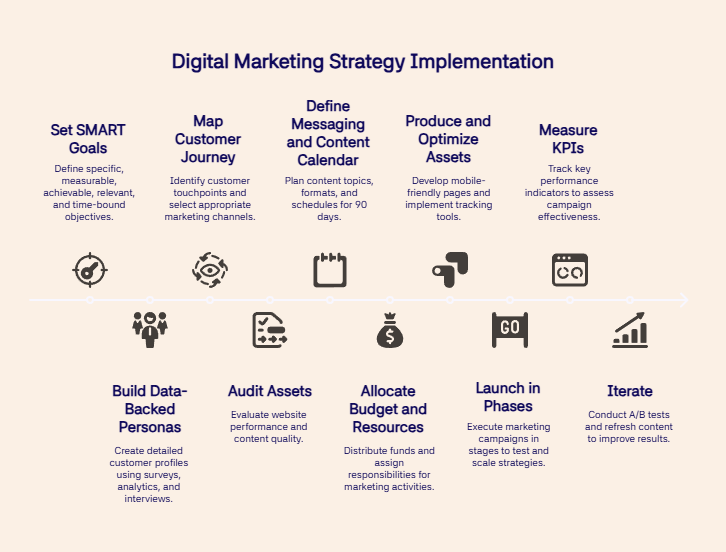
-
Set SMART goals (e.g., grow email subscribers by 50% in 6 months; cut CPA 20% in 90 days).
-
Build data-backed personas from surveys (50–200 responses), analytics, and interviews; capture location, income, interests, and pain points.
-
Map the customer journey and pick channels (SEO, email, social, PPC) that match intent.
-
Audit assets: crawl your site, inventory content, review analytics; target <2.5s page speed and pass Core Web Vitals.
-
Define messaging and a 90‑day content calendar (topics, formats, owners, publish dates).
-
Allocate budget and resources: decide in‑house vs. agency; assign 20–30% to content, 30–50% to PPC, 10–20% to SEO, 5–10% to tools.
-
Produce and optimize assets: mobile‑first pages, single CTA, schema markup; set UTM tags and pixels.
-
Launch in phases: run 2–4 week pilots, then scale winners.
-
Measure KPIs weekly/monthly: CVR, CPL, CAC, CTR, CPC, ROAS, LTV:CAC ≥ 3:1.
-
Iterate: A/B test 1–2 experiments per channel monthly; refresh top content quarterly; do quarterly strategy reviews.
FAQs
What’s the difference between digital marketing and online marketing?
The main difference between digital marketing and online marketing is scope. Digital marketing includes all digital channels like email, apps, and SMS, while online marketing focuses only on internet-based methods like SEO, PPC, and social media. Digital marketing is broader; online marketing is a subset.
How long does it take to see results from digital marketing?
Digital marketing results typically appear in 3–6 months. SEO may take 6–12 months for steady rankings, while PPC and social ads can deliver leads immediately. Content marketing and email campaigns build momentum over time, with the strongest long-term ROI coming from consistent, data-driven execution.
Which digital marketing channel has the highest ROI for small businesses?
Email marketing delivers the highest ROI for small businesses, with averages of $36–$40 return for every $1 spent. SEO also drives high long-term ROI by generating organic traffic without ongoing ad spend. Combining both email and SEO helps maximize cost-effectiveness and sustainable growth.
What tools do I need to run a successful digital marketing campaign?
Successful digital marketing campaigns require tools across categories: Google Analytics and Search Console for tracking, SEMrush or Ahrefs for SEO, Mailchimp or HubSpot for email, Hootsuite or Buffer for social scheduling, Google Ads for PPC, and Canva for content design. These tools streamline execution, measurement, and optimization.
Can I do digital marketing on my own or should I hire an agency?
You can do digital marketing on your own if you have time, skills, and access to tools. DIY works for startups with limited budgets. Hiring an agency is better if you need expertise, faster execution, and scalable results. Agencies bring experience, specialized tools, and proven strategies.
How do I track the ROI of my digital marketing campaigns?
Track ROI by comparing revenue generated to total marketing costs. Use Google Analytics to measure conversions, attribution, and customer lifetime value. Calculate ROI with the formula: (Revenue – Cost) ÷ Cost × 100. Focus on metrics like CAC, CPL, and ROAS to evaluate performance accurately.
What are some common digital marketing mistakes to avoid?
Common mistakes include targeting the wrong audience, ignoring SEO basics, skipping mobile optimization, relying only on paid ads, neglecting analytics, and producing inconsistent content. Avoiding these pitfalls ensures better engagement, cost efficiency, and long-term growth from digital marketing efforts.
Where can I find affordable digital marketing services for my business?
Affordable digital marketing services can be found through freelance platforms like Upwork and Fiverr, specialized small-business agencies, and SaaS tools offering bundled marketing features. Look for providers offering clear pricing, transparent KPIs, and scalable packages that fit your business stage and budget.
Wrap Up
Digital marketing has fundamentally changed how businesses connect with customers in the 21st century. As people spend more time online daily, marketers have shifted from traditional print, TV, and radio to digital platforms where their audiences actually are.
Understanding the types of digital marketing, tracking the right KPIs, and implementing a solid strategy isn't just helpful anymore – it's essential for business success.
Small startups and established companies alike need to master these digital tools to reach more customers and grow their business effectively.


